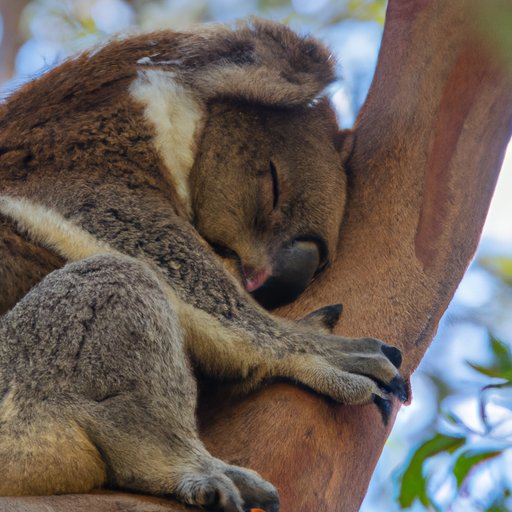
Introduction
Koalas are perhaps one of Australia’s most iconic animals, with their distinctive appearance and “cute” factor known worldwide. However, these marsupials face a number of health challenges that could potentially threaten their populations. As such, understanding koala health and the threats they face is crucial to ensuring their survival for future generations.
The purpose of this article is to provide an in-depth exploration of the diseases affecting koalas, their unique health challenges, the conservation efforts being made to protect them, and the impacts of the recent bushfires on their health and populations. By delving into these topics, we can better understand the importance of preserving koalas for the future.
Understanding Koala Health: Common Diseases Affecting Australia’s Iconic Marsupials
Koalas can be susceptible to a range of illnesses and diseases that can significantly impact their health and survival. Some of the most common diseases include chlamydia, koala retrovirus (KoRV), and mange.
Chlamydia is a bacterial infection that can cause infertility, blindness, and even death in koalas. KoRV, on the other hand, is a retrovirus that can weaken the immune system and lead to cancer, anemia, and other complications. Mange is caused by mites that burrow into the koala’s skin, which can cause inflammation, scarring, and fur loss.
These diseases can spread through various means, including direct contact, contaminated food or water sources, and even from mother to joey. They can have devastating impacts on koala populations, leading to declines and sometimes even extinction.
Behind the Adorable Exterior: The Secret Health Challenges Facing Koalas
In addition to the common diseases that affect koalas, they also face a number of unique health challenges that can pose a threat to their survival. For example, habitat loss due to land development, logging, and agricultural practices has significantly reduced the amount of suitable eucalyptus forest available to koalas as a food source.
Climate change is also posing a growing threat to koalas, as changing weather patterns affect the quality and availability of eucalyptus leaves, which makes up the majority of their diet. This has led to more frequent and severe malnutrition in koalas, which in turn, can make them more susceptible to disease.
Finally, genetic diversity is a crucial component of healthy populations, yet koalas have a very narrow gene pool due to low numbers and habitat fragmentation. This can lead to inbreeding, which increases the risk of genetic abnormalities and susceptibility to disease.
Koala Care: How Conservationists are Fighting to Keep These Critters Healthy
A number of conservation efforts are underway to help protect koalas and ensure their continued survival. These efforts include habitat restoration and protection, welfare programs, immunization programs, disease monitoring, and public education initiatives.
Conservationists are also conducting research and using advanced technologies to better understand the challenges facing koalas and develop effective strategies for addressing them. For example, advances in genetics research are helping to identify healthy breeding pairs and to introduce new genes into the population to increase diversity.
From Chlamydia to Koala Retrovirus: A Comprehensive Look at Koala Diseases
Chlamydia is perhaps the most well-known disease that affects koalas, with prevalence rates ranging from 40-70% in some populations. Symptoms of the disease can include eye infections, mucous discharge, and urinary tract infections. Treatment involves antibiotics, however, koalas will often experience recurrences of the disease even after successful treatment, which can have impacts on their fertility and overall health.
KoRV is a relatively new disease that has been identified in koalas, and it is thought to have been introduced into the population through cross-species transmission from mice. The virus can impact the immune system, leading to an increased risk of other infections and diseases. While there is currently no known cure for KoRV, there are some promising vaccine trials underway.
Mange is caused by the parasitic mite Sarcoptes scabiei, and it can cause severe skin irritation, fur loss, and potentially fatal infections. Treatment can involve pesticides and antibiotics, although it can be difficult to treat and can sometimes lead to itching and self-mutilation in affected koalas.
Koala Health in the Wake of the Australian Bushfires: Current Challenges and Recovery Efforts
The recent bushfires in Australia have had a significant impact on koala populations and their health. Estimates suggest that up to 80% of some populations may have been lost, and many surviving koalas are now homeless, hungry, and vulnerable to disease.
Conservationists and wildlife experts are working together to rescue injured and displaced koalas, provide medical treatment, and create new habitats for them to live in. These efforts are crucial to ensuring the long-term survival of koalas, but there are still many challenges and unknowns as to how their populations will recover in the long-term.
Conclusion
As we have seen, koalas face a range of health challenges that could potentially threaten their populations if left unchecked. However, there are many ongoing efforts to better understand these challenges and to protect koalas for future generations.
Whether through conservation efforts, public education, or simply spreading awareness of the issues facing koalas, we all have a role to play in ensuring the survival and health of these beloved creatures.





